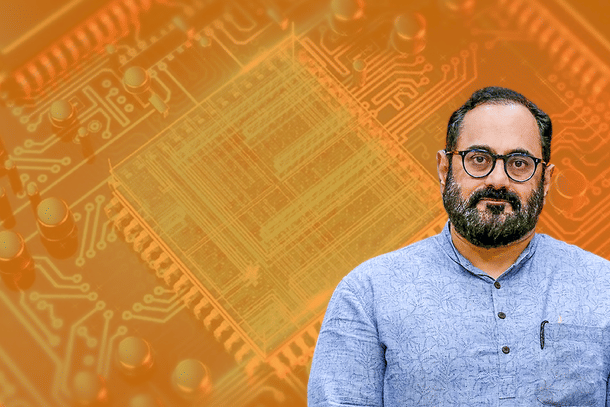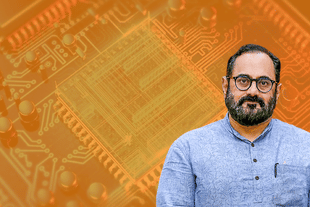Technology
New Plan To Be Released To Develop Tech Champs, Govt Also Working On Establishing Fabs: Rajeev Chandrashekhar
Bhaswati Guha Majumder
Sep 30, 2021, 02:20 PM | Updated 02:20 PM IST
Save & read from anywhere!
Bookmark stories for easy access on any device or the Swarajya app.


As China continues to put pressure on tech companies with an intention to take control of the corporate world along with society, industry experts believe that such moves by Chinese authorities have shown India a new road of opportunities.
Now, according to Rajeev Chandrashekhar, Minister of State for Electronics and IT, the government is working on a policy roadmap to develop champions in the design of electronic systems and semiconductors.
Chandrashekhar, who is also Union Minister of State for Skill Development and Entrepreneurship, said the government intends to unveil new initiatives as early as October 2021.
As reported, Chandrashekhar said that his ministry is trying diligently to realise the goal of establishing a semiconductor fabrication unit (fab) in India, which he expects to happen in the next 3-5 years.
He said on 29 September, during the Global FinTech Festival (GFF) 2021: “We have champions in the software space, we have champions on the internet and fintech and many other areas that are essentially software-driven, but (not many) in the electronic systems design space, in the semiconductor design space.”
There was a strategy that was swiftly put together when he joined the ministry on 7 July to extend and deepen India’s electronics manufacturing and electronics skills, Chandrashekhar said, adding that “you will be seeing this being rolled out in October”.
According to him, India does not wish to be known just for its software. He said: “We want to be capable providers, global leaders in the systems design part, and with some luck, semiconductor design. If the Prime Minister's vision really plays out, we will soon have a fab in this country in the next three to five years."
As the chip shortage issue is expected to stretch into 2023, the Indian government has stepped up attempts to launch chip production in India.
It was reported recently, India and Taiwan are in talks on a deal that may bring chip production to the region, as well as tariff reductions on components used to make semiconductors by the end of the year. The officials from both countries have met recently to negotiate a proposal that would bring a chip facility worth $7.5 billion to India, which would lead to the supply of everything, including 5G devices and electric cars.
According to Chandrashekhar, Indian IT businesses must grasp the “Y2K-like" potential presented by the post-Covid-19 world. Additionally, he said that they must play a larger role in upskilling talent at scale to take advantage of the opportunities generated by growing digitisation because of the Covid-19 pandemic.
The world has changed drastically and the rate of digitisation has accelerated considerably. As a result, demand for digitisation and skill is expected to skyrocket, said the Minister adding that ”we must recognise that we are in the post-Covid-19 world, in almost a Y2K-like moment for the Indian tech space”.
He also said: “We are at an unprecedented inflection point in terms of opportunities for growth. If we don't make the move quickly, somebody else will take this breakfast and lunch.”
The abbreviation Y2K stands for "the year 2000." The significance is that a so-called "Millennium Bug," a computer flaw, caused panic and the Y2K scare.
Engineers utilised a two-digit code for the year, omitting off the "19," when complicated computer systems were initially created in the 1960s. As the year 2000 neared, many people predicted that the systems would misinterpret the "00," resulting in a huge malfunction in the system. While there was broad concern about the possible consequences of this on banks, transportation and technology, not much happened.
But this Y2K scare helped India's IT sector. The United States began employing individuals to address the bug problem all around the world and India supplied a large number of engineers to do so.
The need to repair this problem also boosted India's BPO (Business Process Outsourcing) business. India supplied highly skilled engineers at a low cost. Many Indian IT firms, such as Infosys and TCS, employed people to bolster their IT hubs such as Bangalore and Hyderabad.
However, earlier it was reported that in India the development of skills and talents is a major component of the Ministry of Electronics and IT's 1,000-day programme to achieve the $1 trillion digital economy objective. In three years, the government hopes to develop a 10-million-strong trained IT workforce. In 1998, the IT industry generated 1.2 per cent of India's GDP; now, it contributes 7.7 per cent.
Chandrashekhar explained that “industry and industry associations have to step up, I think, and do a lot more, especially in this post-Covid era.”
Additionally, he said: “We are 100 per cent committed to putting our money into the budget for training and skilling, expanding the network...the industry needs to seize this opportunity and look at skilling as a big challenge for which they need to play a bigger role.”
According to Chandrasekhar, the financial industry has dramatically altered to embrace fintech as a very essential, fundamental component of the financial economy.
It has increased entrepreneurship, innovation and job possibilities, he said, adding that without a question, it is currently getting huge amounts of both local and international investment; “it has created entrepreneurship, unicorns, leading-edge, confident, ambitious entrepreneurs who are going out there and unambiguously leading the world in terms of the platforms and solutions that they are putting out there”.





